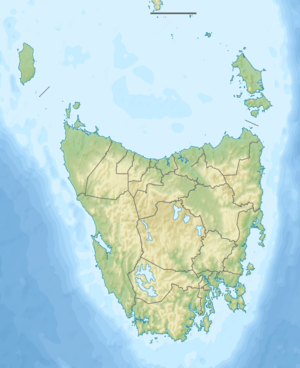Eddystone (Tasmania)
Eddystone is a tower-shaped rock or small island, located in the Southern Ocean, off the southern coast of Tasmania, Australia.[2] The island is situated approximately 27 kilometres (17 mi) from the South East Cape on a bearing of 149° and is contained within the Southwest National Park, part of the Tasmanian Wilderness World Heritage Site. An erosional remnant of the Tasmanian mainland with an elevation of 30 metres (98 ft) above sea level, the island is estimated to have separated from the Tasmanian mainland at least 15,000 years ago.[3]
| Native name: no known native connection | |
|---|---|
| Etymology | Eddystone Lighthouse in Devon, England.[1] |
| Geography | |
| Location | Southern Ocean |
| Coordinates | 43°51′18″S 147°00′00″E |
| Highest elevation | 30 m (100 ft) |
| Administration | |
Australia | |
| State | Tasmania |
| Region | Southern |
| Demographics | |
| Population | 0 |
Features and location
Eddystone is known for its inaccessibility and distinctive shape, described by Abel Tasman in 1642 as "a tall, obtuse, square tower".[4] A painting[5] from 1823 bears this out, and also shows its proximity to Pedra Branca, 2.2 kilometres (1.4 mi) to the west.
Approximately 50 metres (160 ft) off Eddystone there is a recently publicised surf break named Eddystone Rock. Surfers were shown the location by local fishermen, who have known about the break for many years.
The island has negligible plant life. Seabirds recorded as nesting there include Australasian gannets, black-faced cormorants and fairy prions.[6] Australian and New Zealand fur seals haul-out on the lower ledges when seas are not too rough.[1]
Important Bird Area
Together with the nearby Pedra Branca and Sidmouth Rock the island constitutes the 2-hectare (4.9-acre) Pedra Branca Important Bird Area (IBA), identified as such by BirdLife International because it supports over 1% of the world populations of shy albatrosses and Australasian gannets.[7]
Etymology
Eddystone was named by Captain James Cook in 1777 because of its resemblance to Eddystone Lighthouse in Devon, England.[1]
References
- Brothers, Nigel; Pemberton, David; Pryor, Helen; Halley, Vanessa (2001). Tasmania's Offshore Islands: seabirds and other natural features. Hobart, Tasmania: Tasmanian Museum and Art Gallery. pp. 510–511. ISBN 978-0-7246-4816-0.
- "Eddystone (TAS)". Gazetteer of Australia online. Geoscience Australia, Australian Government.
- "Pedra Branca Skink". Tasmania Parks and Wildlife Service. pp. 563–569. Retrieved 16 July 2006.
- Heeres, J E (Editor) (2006). "Abel Janszoon Tasman's Journal of his Discovery of Van Diemen's Land and New Zealand in 1642 with Documents Relating to his Exploration of Australia in 1644...to which are added his Life and Labours, 1898". Project Gutenberg of Australia. Retrieved 9 July 2006.CS1 maint: extra text: authors list (link)
- Boyes, G. T. W. B. (1823). "Pedra Branca and Eddistone; Tasmans Head". State Library of Tasmania. Archived from the original on 26 August 2006. Retrieved 2006-07-21.
- "Small Southern Islands Conservation Management Statement 2002" (PDF). Tasmania Parks and Wildlife Service. 2002. Archived from the original (PDF) on 22 August 2006. Retrieved 2006-07-20.
- "IBA: Pedra Branca". Birdata. Birds Australia. Archived from the original on 6 July 2011. Retrieved 2011-09-16.
